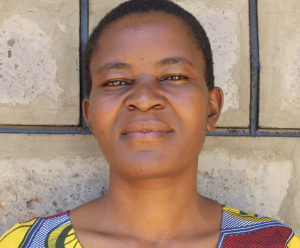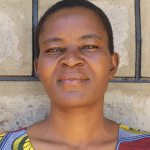March, 2020: Chiliva Primary School Project Complete!
Chiliva Primary School in Kenya now has access to a new source of safe, clean water thanks to the completion of their rain tank, which has the ability to collect 50,000 liters of water. We installed new latrines and handwashing stations for students, and we trained students and staff on improved sanitation and hygiene practices. All of these components work together to unlock the opportunity for these students to live better, healthier lives.

Students stand with the new rain tank
"We are so humbled as the Chiliva community and thanking God who brought you to this school," said Head Teacher Joyce Mmbone.
"This project has brought smiles on our faces and we are going to recover the time that was wasted looking for water. Our school is going to improve on academics. Absenteeism has been an issue because some pupils would fear carrying water to school. The water from the spring has not been safe for drinking since pupils and we as teachers would suffer from waterborne diseases but now we are safe. Boys would share toilets with girls but now we will separate them."

Student enjoying the rain tank water
Rain Tank
Construction for this 50,000-liter rain tank was successful!
Parents, staff, and students helped our artisans gather everything needed for construction. All the while, the school cooks prepared meals for the artisans, and the school provided accommodations for the artisans during their work. Local women and men helped our artisans with their manual labor, too.

Students carry bricks to the construction site
The process officially began with our staff and school administration looking around the school compound to try and determine the best location for a new rain tank. This needed to be the best site with good, clean roofing to catch the rainwater.
Then, we cleared the site by excavating the soil within the required measurements to make level ground for the tank foundation. The foundation was cast by laying hardcore on level ground and then reinforcing it using steel, concrete and waterproof cement.

Filling in the rain tank's stone foundation
Both the drawing pipe as well as the washout pipe were affixed as the foundation was laid. The wall was built with ferro-cement techniques through 6 layers. The inner wall was plastered while rough casting was done on the outer part. Finally, the catchment area was dug, plastered, and a short staircase installed.

Artisan and laborers work on interior plaster
Dome construction could begin after the superstructure had been given enough time to settle. The manhole cover was fitted, inlet pipes were connected to the roof gutters, inlet screens, ventilation pipes (breathers) and overflow pipes were all done to standard.

Fitting the gutter system to the rain tank
Once finished, the rain tank was given 3 weeks to undergo complete curing before it was cleaned and handed over to Chiliva Primary School. As soon as the tank was ready for use, students and staff celebrated the presence of clean water on campus. The event was a great chance for us to acknowledge the school administration and students as the primary parties entrusted with the tools we’ve given, as well as remind them of our continued support as they develop. Happiness, thanksgiving, and appreciation were the order of the day flowing in all directions.

Student enjoying a cup of water from the rain tank
"The new water point has changed the face of this school. We are now safe because we have plenty of clean and safe water for drinking. May God increase your work!" said Sanitation Teacher Pamella Barasa.
VIP Latrines
This project funded the installation of 6 new ventilated improved pit (VIP) latrines, half for girls and half for boys. All of these new latrines have cement floors that are designed to be easy to use and clean. And with a rain tank right on school property, there should be enough water to keep them clean.

A pupil stands proudly with the new girls' latrines
Handwashing Stations
The 2 handwashing stations were set up during training and handed over to the student health club. These were placed outside of the girls’ and boys’ latrines to encourage handwashing after latrine use.

Handwashing
Health club members will teach other students how to properly wash their hands at the stations, make sure the stations are filled with water, and work to ensure that there is always a cleaning agent such as soap or ash available.

Handwashing
New Knowledge
Hygiene and sanitation training was scheduled with the help of the school principal and Head Teacher Joyce Mmbone, who together ensured that the training date would be convenient for students, staff, and parent representatives. Individual teachers helped by selecting students from each class to represent the others.
Some 24 students and staff attended training, which was a good turnout as we were originally only expecting 20. It was a bit cold when we started the training but the event was not affected in any way. We conducted the training under a tree in the school compound which was a conducive environment for learning. The level of participation was good as all of the pupils were active and ready to learn. They asked questions when they did not understand and they were also eager to participate in demonstrations.

Lots of participation at training
We covered a number of topics including personal hygiene such as bathing, oral hygiene, and the 10 steps of handwashing; environmental hygiene; child rights; operation and maintenance of the rain tank, latrines, and handwashing stations; and leadership and governance. During the latter, the students elected their peers to lead their newly formed student health club.

A student stands to answer a prompt at training
The club will be greatly involved in the water, sanitation, and hygiene project management at school and will be responsible for encouraging good health and hygiene practices amongst their peers, teachers, and the larger community. We involved stretches, dances, and physical activities in between each topic to keep the pupils’ energy up and their minds active. By the end of the training, each pupil understood their role in sustaining clean water and good health within their school community.

A student demonstrates handwashing using a leaky tin
When an issue arises concerning the water project, the students and teachers are equipped with the necessary skills to rectify the problem and ensure the water point works appropriately. However, if the issue is beyond their capabilities, they can contact our team of field officers to assist them. In addition, we will continue to offer them unmatchable support as a part of our ongoing monitoring and maintenance program.

Students learn about the parts of the rain tank
A memorable moment from the training was from the operations and maintenance session. While the facilitator was explaining about taking care of the rain tank, she explained that it is highly important to cure it properly. Before she could explain further, one of the participants asked if the tank was sick and we all laughed. Trainer Rose then got the chance to explain in more detail about the curing process that helps stabilize the cement and plaster.
Another special topic was primary healthcare when participants realized they could use cheap and often free items in place of store-bought ones to maintain personal hygiene. These were things like soft chewed sticks instead of toothbrushes, and salt or ask instead of toothpaste and soap.
"I want to thank you for teaching us new skills. We will share the information with other pupils who are not here. The club you have formed this day will enable us to go far," said pupil Catherine.
Thank you for making all of this possible!


 Rainwater Catchment
Rainwater Catchment
 Rehabilitation Project
Rehabilitation Project




































